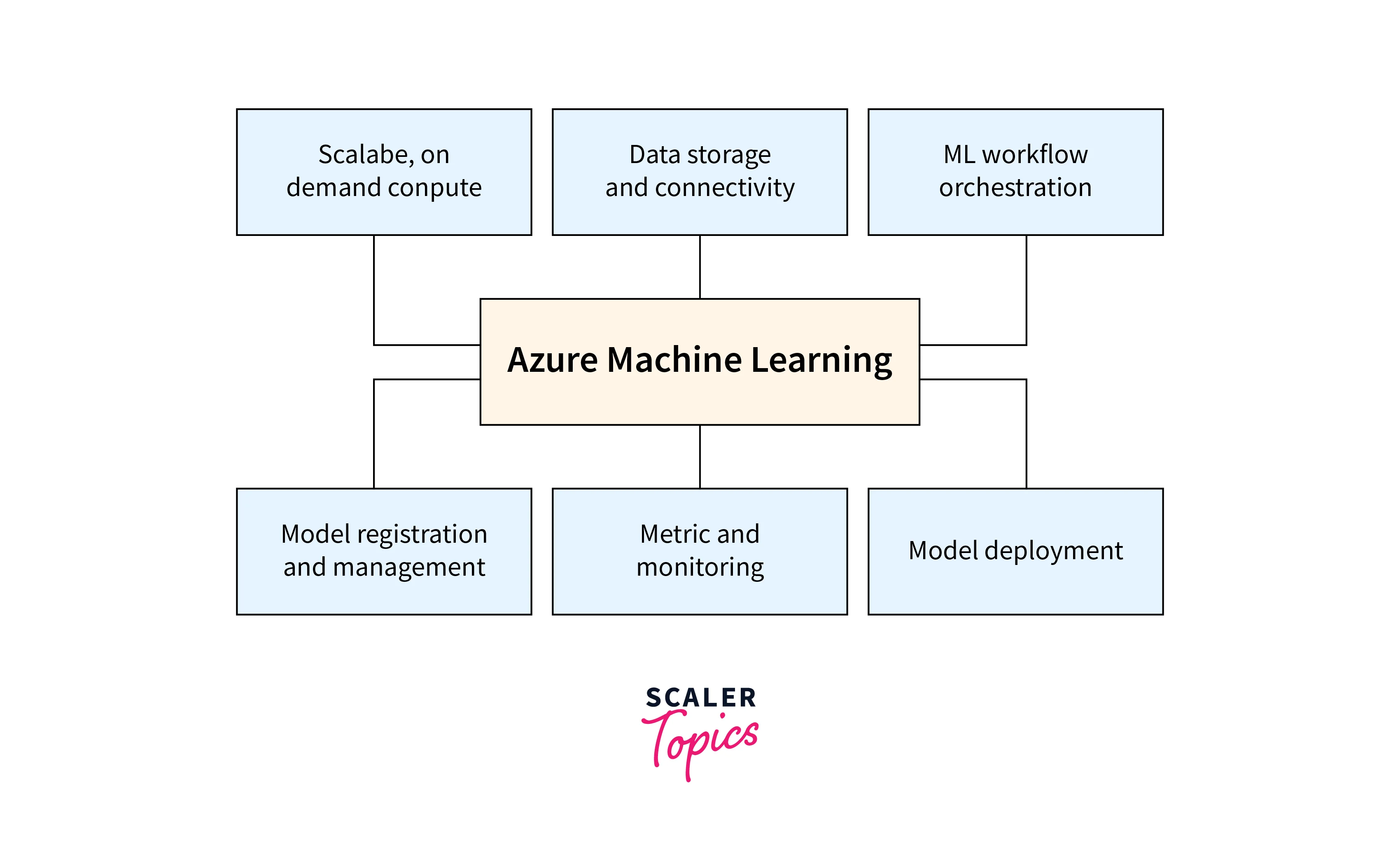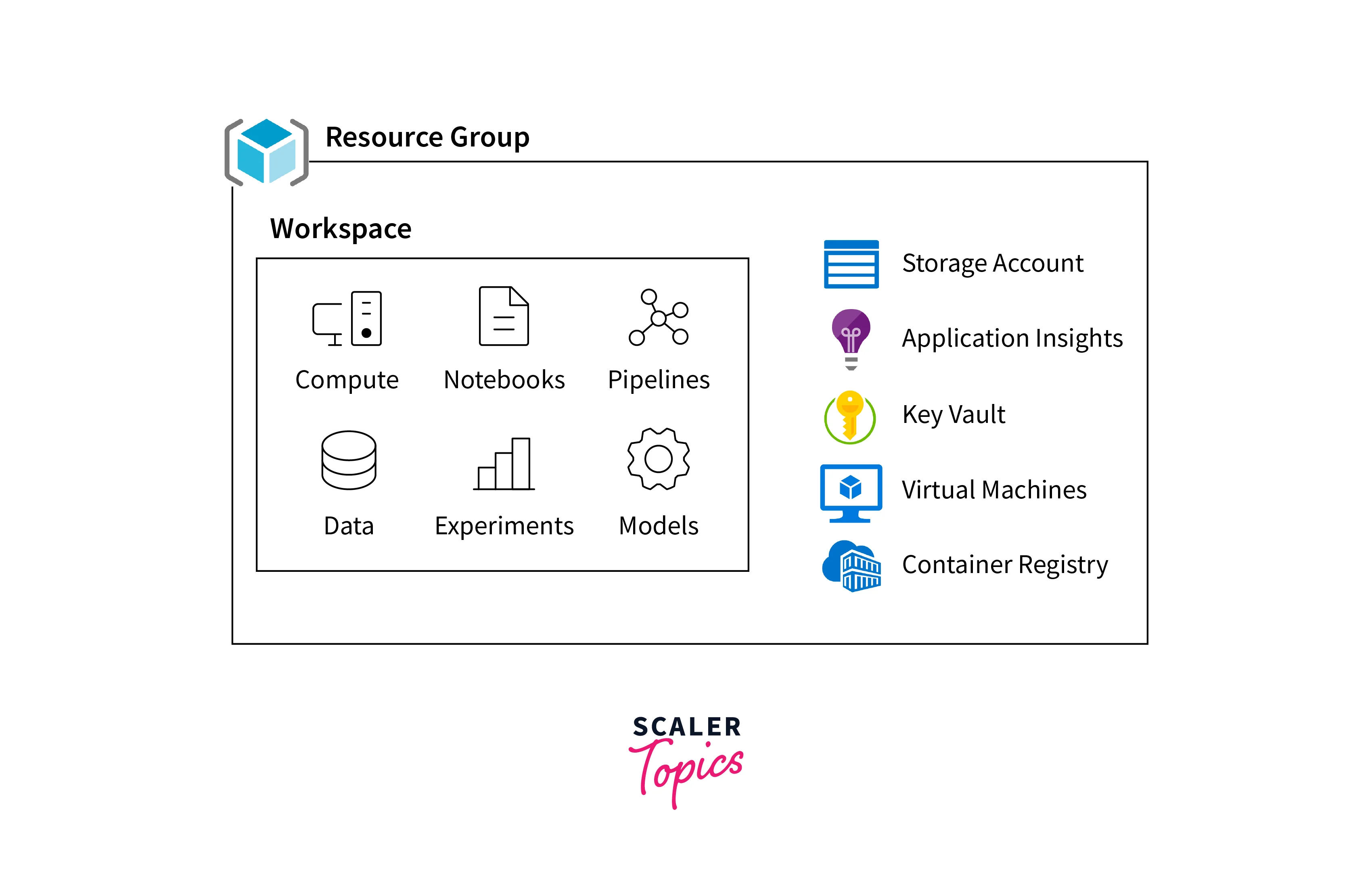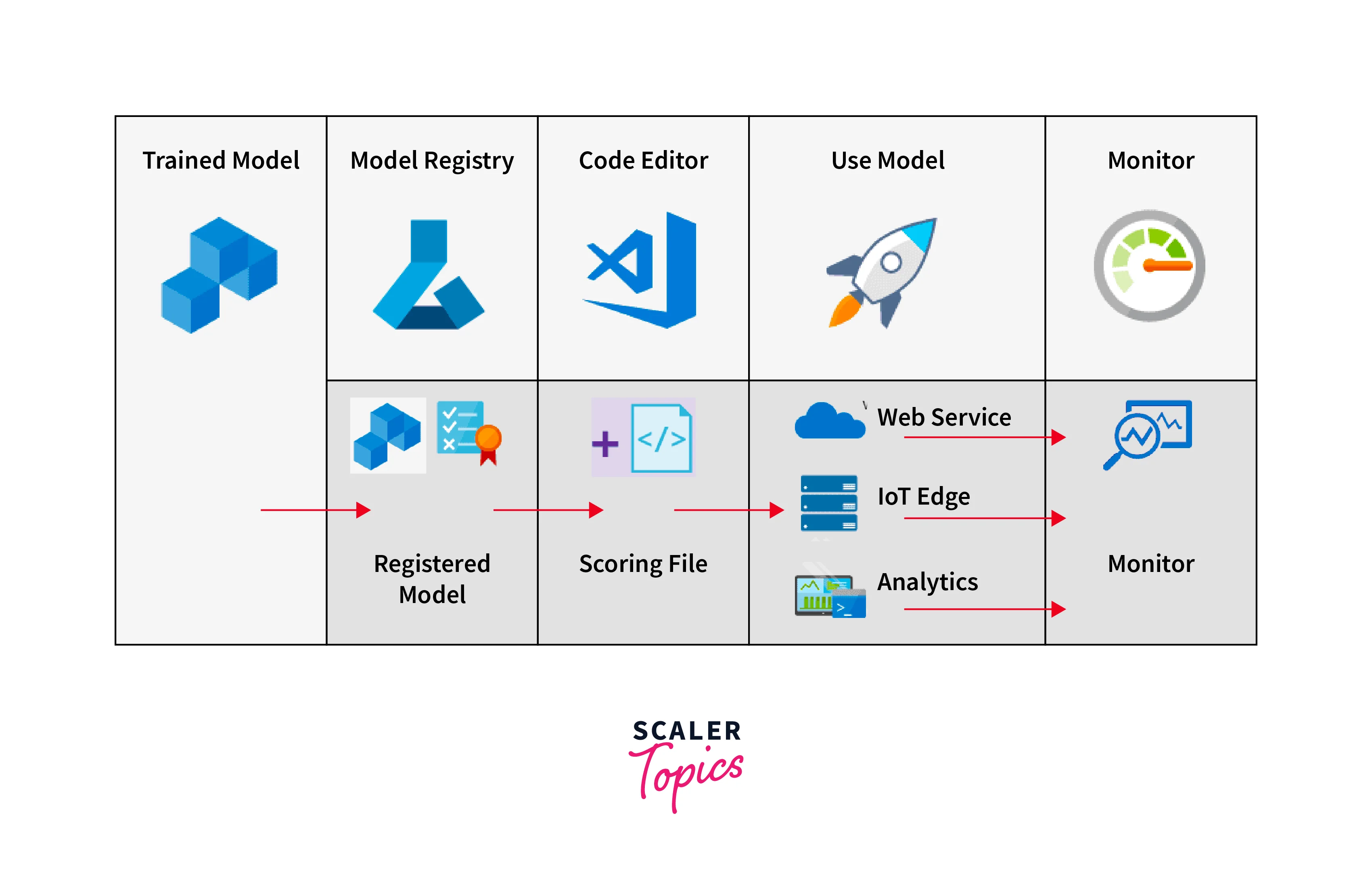Microsoft Azure Machine Learning Service
Overview
Microsoft Azure Machine Learning Service is a cloud-based platform that empowers businesses to build, deploy, and manage machine learning models at scale. It offers a comprehensive suite of tools for data preparation, model development, and operationalization. With seamless integration into Azure ecosystem, it enables users to leverage powerful algorithms, automated machine learning, and distributed computing for predictive analytics and AI-driven solutions. Azure Machine Learning Service streamlines the end-to-end machine learning lifecycle, facilitating collaboration among data scientists, engineers, and developers to create intelligent applications and drive data-driven decisions.
Features Of Azure Machine Learning Service
Azure Machine Learning Service is a powerful cloud-based platform developed by Microsoft that enables organizations and data scientists to harness the potential of machine learning. It offers a wide array of features designed to facilitate every stage of the machine learning lifecycle, from data preparation and model development to deployment and monitoring.

- Data Preparation and Exploration:
A solid foundation is essential for effective machine learning. Azure Machine Learning provides tools to access, clean, and preprocess data from various sources. This ensures that data is in a suitable format for training and analysis. Users can also perform exploratory data analysis to gain insights into the dataset, identifying patterns and potential challenges. - Automated Machine Learning (AutoML):
Not all users are machine learning experts, and AutoML addresses this gap. Azure Machine Learning's AutoML feature automates the model selection, hyperparameter tuning, and feature engineering processes. This empowers users without extensive machine learning knowledge to create high-quality models efficiently. AutoML explores multiple algorithms and hyperparameters to find the best-performing model, saving time and resources. - Custom Model Development:
For advanced users and specific use cases, Azure Machine Learning supports custom model development using popular frameworks like TensorFlow, PyTorch, and scikit-learn. This feature allows data scientists to design and fine-tune models tailored to their unique requirements. They can experiment with various architectures and techniques to achieve optimal performance. - Model Interpretability:
Understanding how a machine learning model arrives at its decisions is crucial, especially in sensitive domains. Azure Machine Learning offers interpretability tools that help users comprehend the factors influencing a model's predictions. This feature enhances transparency, accountability, and trust, making it easier to explain model outputs to stakeholders. - Model Deployment and Management:
Deploying a model into production is a critical step in the machine learning process. Azure Machine Learning Service supports various deployment options, such as Azure Kubernetes Service (AKS) for scalable containerized deployments, and Azure Functions for lightweight scenarios. This flexibility accommodates different deployment needs while providing tools to monitor and manage deployed models effectively. - Monitoring and Retraining:
Models deployed using Azure Machine Learning can be monitored in real-time to track their performance and identify potential issues. If a deployed model's accuracy declines over time due to changing data patterns, the platform can trigger automatic retraining to maintain predictive quality. This proactive approach ensures that deployed models remain accurate and relevant. - Integration with Azure Ecosystem:
Azure Machine Learning seamlessly integrates with other Azure services, creating a comprehensive ecosystem for data management, processing, and analytics. Integration with services like Azure Databricks, Azure Data Factory, and Azure DevOps enables end-to-end data pipelines and supports collaborative workflows among teams. - Scalability and Performance:
Leveraging Azure's cloud infrastructure, Azure Machine Learning offers scalability and high performance to accommodate varying workloads. Users can easily scale resources up or down based on demand, optimizing resource utilization and ensuring efficient processing of machine learning tasks. - Security and Compliance:
Data security and compliance are paramount in machine learning projects. Azure Machine Learning Service provides features such as Azure Active Directory integration, role-based access control, and encryption to safeguard sensitive data and adhere to regulatory requirements. This allows organizations to build machine learning solutions while maintaining data privacy and compliance. - Experiment Tracking and Versioning:
Managing and tracking experiments is simplified through Azure Machine Learning's capabilities. Users can keep detailed records of different model versions, parameter settings, and experiment outcomes. This feature promotes collaboration, facilitates knowledge sharing, and ensures reproducibility of results. - Hybrid Cloud Capabilities:
Recognizing the diverse infrastructure needs of organizations, Azure Machine Learning offers hybrid capabilities. Users can seamlessly integrate on-premises data and resources with Azure's cloud services, enabling hybrid machine learning workflows that leverage the strengths of both environments. - Cost Management:
Azure Machine Learning provides various pricing options to accommodate different usage patterns and budget constraints. Users can take advantage of features like Azure Cost Management to monitor and optimize spending on machine learning resources.
Workflow Of Azure Machine Learning Service
The workflow of Azure Machine Learning Service follows a systematic and iterative process, enabling organizations to efficiently create, deploy, and manage machine learning solutions. This end-to-end workflow encompasses various stages, from data preparation and model development to deployment, monitoring, and maintenance.

Some Challenges and Consideration for using Azure Machine Learning Service:
- Overfitting:
Azure ML provides automated machine learning, which applies regularization techniques and cross-validation to mitigate overfitting by optimizing model complexity. - Data Bias:
The platform offers tools for data preprocessing and fairness assessment, helping detect and mitigate biases in training data, ensuring ethical AI deployment. - Model Interpretability:
Azure ML offers interpretability tools to explain model predictions, like SHAP values, aiding in understanding complex models and building trust with stakeholders. - Hyperparameter Tuning:
The platform automates hyperparameter tuning, optimizing model performance and reducing the chances of overfitting. - Explainable AI:
Azure ML integrates tools like Azure Machine Learning InterpretML to provide transparent and human-readable insights into model behavior.
Prepare Data
In Azure Machine Learning Service workflow, Prepare Data is a crucial initial step that involves getting the raw data ready for analysis and model development. This process includes several key tasks:
- Data Collection:
Data from diverse sources like databases, files, and APIs is collected and brought into the Azure environment for processing. - Data Cleaning:
Raw data often contains noise, errors, and inconsistencies. Data cleaning involves identifying and rectifying these issues to ensure data quality and reliability. - Data Transformation:
Data may need to be transformed into a suitable format for analysis. This can include converting categorical variables, scaling numerical features, and normalizing data. - Handling Missing Values:
Dealing with missing data is essential. Techniques like imputation or removing records with missing values are used to address this. - Feature Engineering:
This involves selecting relevant features and creating new ones that contribute to model accuracy. It can include creating derived attributes or aggregating information. - Exploratory Data Analysis (EDA):
EDA is performed to understand the data's characteristics, relationships, and patterns. Visualizations and statistical summaries aid in this exploration. - Data Splitting:
The dataset is typically divided into training, validation, and testing subsets to assess and optimize model performance.
Some supported Azure services that can be registered as datastores are:
- Azure Data Lake
- Azure SQL Database
- Databricks File System
- Azure Blob Container
Experiment
Once the data has been registered and stored within the dataset, the subsequent phase involves the construction, training, and validation of the model.
Model
A model, in this context, is a software component designed to take input and generate corresponding outputs based on the provided inputs. When developing a machine learning model, the process entails the careful selection of an appropriate algorithm, acquisition of necessary data, and the refinement of hyperparameters. The training phase encompasses an iterative procedure through which a model is imbued with knowledge acquired during the training process.
Compute Targets
Compute Target plays a significant role in this process. These refer to either a singular machine or a collection of machines employed to execute training scripts or host service deployments. Such compute resources can be a local machine or a remote computational asset. The compute targets used are integrated with the workspace and are categorized into four distinct types:
- Local Computer:
This designates the computational environment where the code for experiment submission is executed. - Compute Cluster:
A virtual cluster managed by Azure Machine Learning that serves as a resource for computation. - Inference Cluster:
A deployment target based on containers, facilitating the deployment of trained models. - Attached Compute:
This encompasses resources like Azure Databricks and Azure Data Analytics, further expanding the range of available compute options.
Commonly Used Metrics
- Accuracy:
Measures overall correctness, but can be misleading with imbalanced classes. - Precision:
Focuses on true positives among predicted positives, useful when false positives are critical. - Recall:
Measures true positive rate among actual positives, important when false negatives are crucial. - F1-Score:
Harmonic mean of precision and recall, balances both metrics. - ROC Curves:
Graphical representation of true positive rate vs. false positive rate, shows trade-offs in classifier performance. - Area Under ROC Curve (AUC):
Quantifies ROC curve's predictive power, higher AUC indicates better model discrimination. - Confusion Matrix:
Tabulates true/false positives/negatives, provides comprehensive performance overview.
Deployment
Once the model has undergone training and testing phases, it becomes stored within the model registry, subsequently advancing to the deployment stage where it is made operational through web services or integrated into IoT modules.

Deployment within the realm of Azure Machine Learning Service takes shape as an orchestrated process, orchestrated with precision. An "Image" serves as the vessel for deployment, creating an independent habitat where the model can thrive. This encapsulating image amalgamates the model, application, or script harmoniously, along with all requisite dependencies. These images attain residence within the image registry, a repository that safeguards and catalogs them for accessibility.
Within this deployment landscape, two distinct image archetypes come to the forefront:
- FPGA Image:
This type is harnessed during the deployment of a field-programmable gate array within Azure ML. A field-programmable gate array stands as a semiconductor element profoundly integrated into electronic circuits. - Docker Image:
Designed to facilitate the deployment of computational entities like Azure Kubernetes Service or Azure Container Instances, this image class embodies the necessary framework for seamless deployment.
As this journey progresses, deployment materializes into the transformation of the registered model into a service endpoint. This instantiation, performed with finesse, metamorphoses the image into a functional web service hosted within the cloud.
FAQs
Q. How can I evaluate the performance of a trained model in Azure Machine Learning Service?
A. In Azure Machine Learning Service, gauging a trained model's performance involves diverse methods. Metrics like accuracy, precision, recall, and F1-score assess effectiveness. Cross-validation validates results across data subsets. Visualizations aid understanding of predictions vs. outcomes. Azure's tools like SHAP values interpret models. Monitoring real-world deployment ensures ongoing accuracy. This approach ensures a comprehensive evaluation of model performance within Azure ML's ecosystem.
Q. Does Azure Machine Learning Service integrate with other Azure services?
A. Absolutely, Azure Machine Learning Service seamlessly integrates with a spectrum of other Azure services. It harmoniously connects with Azure Databricks for advanced analytics, Azure Synapse Analytics for data warehousing, and Azure Data Factory for data integration. Additionally, it collaborates with Azure Kubernetes Service (AKS) for scalable deployments, Azure Functions for serverless execution, and Azure Active Directory for secure access control.
Q. How does Azure Machine Learning Service support collaboration?
A. Azure Machine Learning Service facilitates collaboration through its collaborative workspace, enabling teams to collaborate on model development, experimentation, and deployment. It offers version control for models and code, allowing multiple contributors to work simultaneously while maintaining a history of changes. Teams can share experiments, pipelines, and datasets, ensuring consistent and transparent development. Integrated tools enable real-time collaboration, such as shared notebooks and experiment tracking. With role-based access control and Azure Active Directory integration, teams can manage permissions and securely collaborate on machine learning projects, enhancing productivity and knowledge sharing.
Q. How does Azure Machine Learning Service handle data preparation?
A. Azure Machine Learning Service streamlines data preparation by offering a range of tools and capabilities. It allows data ingestion from various sources like databases and APIs. Preprocessing tools help clean, transform, and structure data, ensuring it’s suitable for analysis. Feature engineering aids in selecting and creating attributes that enhance model performance. Automated Machine Learning (AutoML) simplifies the process by automating data preprocessing steps. Data exploration tools provide insights into data patterns. Moreover, data pipelines can be defined to automate and manage data preparation workflows. This comprehensive approach ensures that data is well-prepared, high-quality, and ready for subsequent model development.
Conclusion
- Microsoft Azure Machine Learning Service is a cloud-based platform that enables building, training, and deploying machine learning models for various applications.
- Azure Machine Learning Service offers data preparation, model development, deployment, monitoring, collaboration, and integration with Azure services for comprehensive end-to-end machine learning solutions.
- Preparing data in Azure Machine Learning Service involves collecting, cleaning, transforming, and analyzing data to create a structured foundation for effective model development.
- In Azure Machine Learning Service's workflow, an experiment encompasses model development, testing, iteration, and performance evaluation, driving effective machine learning solutions.
- Deployment in Azure Machine Learning Service integrates trained models into operational services or IoT modules for real-world applications and use.
